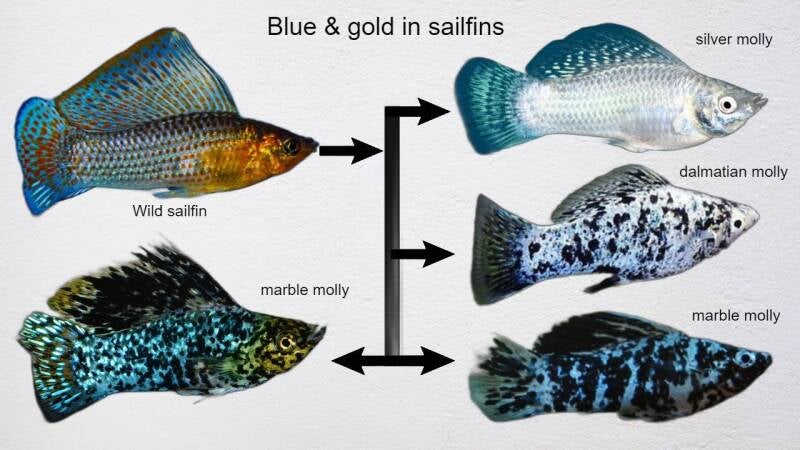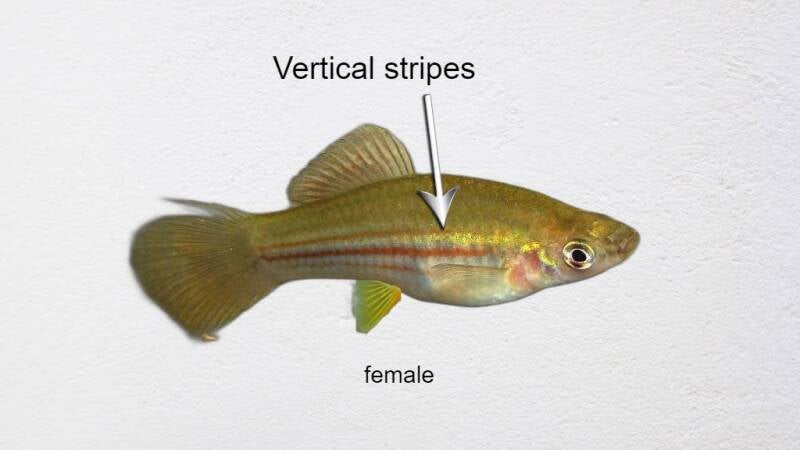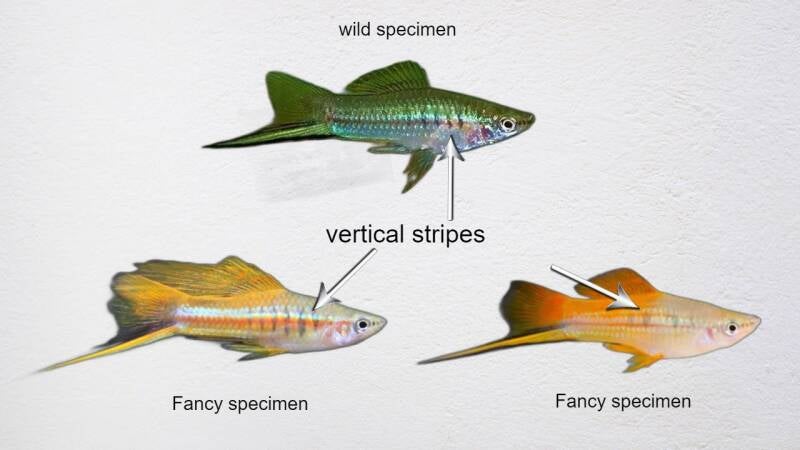Wild traits in livebearer breeding forms
For decades we have been overwhelmed with all kinds of breeding variants of ovoviviparous livebearers. And whether you like it or not, those varieties are simply ruling the commercial market as far as ornamental fish are concerned. We are overpowered with it, especially from Asia. That continent is the top of the masquerade ball to which fish are subjected. Whether that harms their well-being or not. Crazy isn't crazy enough yet...
In itself it is not surprising that various colors and shapes have been introduced to the market over the years. The rapid sales is simply generated by the most colorful and extremely shaped body shapes. The average aquarist who wants to set up a nice tank usually chooses colored fish. Fish farms clearly respond to this and give what the customer wants. Of course there is still a lot to discuss about the ups and downs of ornamental fish. But unfortunately that will be of a minor issue to the commercial market. As long as it sells, the so-called specialists (fish farms, importers, wholesalers and retail) won't complain. They prefer to be labeled as being specialists. But to me a lot of them aren't; specifically the wholesalers, importers and retail. From my own experience, they do lack knowledge. And just note that one can set up a business that offers aquatic stuff and aquatic animals, but that doesn't make them a specialist yet. Certainly not meant negatively from me, but what comes very clearly to me when I talk about them is that trade goes over welfare and knowledge of fish. To a certain extent I do understand that, since it is also business. But we are dealing with living creatures overhere.
Anyway, I want to discuss certain breeding forms of livebearers of which not all phenotypic traits concern a breeding creation. For the layman, all breeding forms are also 100% breeding form. Whether that concerns the color or pattern or the body shape. I see it appear quite frequently on various forums that people think they are dealing with a completely new variant, simply because they haven't seen it as a breeding form before. If I were a layman in this field I would probably react the same way. So, it's not weird that people think that way.

For instance, it's often seen in sailfin mollies that blue or a golden color can be seen under the yellow, white, orange, green, red and black base color. And in one it can be noticed more than in the other specimen. Well, know that both blue and gold actually already exist in wild specimens. The blue can come through very well on certain white specimens. With a white or gray base color in a sailfin molly which belong to the so-called spotted or mottled (with spots, large or small or not) phenotypes, we call the it a dalmatian molly. And otherwise the name changes into "marble" if the spots are larger and look like an all dark specimen. However, with this species it is questionable whether they remain dalmatian or not. Because with age, these spots can grow into very large spots where the body can appear almost completely black. You can also see this happening in wild specimens. Nevertheless, you will often discover a few pieces of blue or / and sometimes pieces of gold color with this type of sailfin molly. It's something that can be traced back to the wild form. Whether this also has to do with, for instance, certain water parameters that make certain color cells (which also occur in the wild) become stronger is not clear. However, it is known that the values of water parameters can influence the intensification of colors. And of course it also depends on the presence and density of the chromatophores (color cells) in the three skin layers of a fish. Nevertheless, the question remains how certain wild traits can still manifest themselves in breeding forms that are already far related from their wild ancestors for decades.

Are blue and gold recessive colors, which due to some trigger after so many generations of breeding forms, manage to come through again phenotypically? That question has still not been answered. It's one of the things I'd like to find out for myself. But it is typical that blue can appear with a white base color and that blue and gold can often develop in a spotted sailfin molly. Or does every breeding form of a sailfin molly still contain wild genes? Who's to say. I also have chocolate mollies that shows gold as the underlying color. The right photo below shows a male chocolate molly that's got some blue shimmer on the sides.


Let's take a look at the breeding forms of swordtail fish. Basically, they can be traced back to the Xiphophorus hellerii. Anyway, it's known that there are several phenotypes of the Xiphophorus hellerii in the wild. That may differ per location. But also within a colony, there can be some diversity in phenotypes. However, what is very typical for a hellerii are the vertical stripes on the chest, which mainly occur in males. I deliberately write here "mainly" because there are also females who show them (these can be women with an allele combination of Aa). Sometimes the vertical stripes even continue on the flanks. Vertical stripes are not only found in X.hellerii. But also other types of wild swordtails "can" (so not all) show them.


You can still see those vertical stripes in many (so, not in all species) swordtail breeding forms. The number of vertical stripes are equal on both sides of the body. However, the number of vertical stripes differ per individual (again: usually male) specimen. These vertical stripes are intended to send a sexual signal to female swordtails. A study with Xiphophorus cortezi found that female specimens preferred males with more vertical stripes and a short distance between each vertical stripe. Males with fewer vertical stripes and more distance between each vertical stripe were more or less pushed aside. It was concluded in this study that it would have to do with the fact that several vertical stripes with a small distance between them are better reflected by the light. And therefore more noticeable by the females. What another study shows for all northern swordtails is that the vertical stripes can be better intensified by the males during courtship and especially in head-to-head collisions with other males compared to the southern swordtails.

These vertical stripes also occur in certain wild platy species. And serve the same purpose.

To stick to the Xiphophorus genus… Nowadays we see markings at the base of the tail in many breeding varieties of the platy and the swordtail. Like, for instance, the so-called “Mickey Mouse platy”. Or for instance, there is a dot on the base of the tail (caudal penducle) or on the tail itself, just to mention another mark. Nowadays, such Mickey Mouse platies come in many color combinations. Most people will think that the markings on the base of the tail are a breeding creation. But that would be an incorrect statement. Those tailspots are wild trait that occurs in several wild platies. The so-called “Mickey Mouse” pattern is named after the Mickey Mouse cap that can be obtained at the Disney theme parks. At least, that's how the commercial name came about. Because the "Mickey Mouse pattern" is actually a combination of two types of markings, namely the "Moon" and the "Twin spot" (also called two spot). And this combination is called the "moon complete" tailspot. So again, the name “Mickey Mouse” is just the commercial name.

For instance, there are several markings on the tail base of breeding variants which can be told of that they can actually already be found in wild forms. These are: one spot, crescent, twin spot, moon, crescent complete, moon complete and the comet. In breeding forms you see them in particular in platy strains of the Xiphophorus maculatus and the Xiphophorus variatus. However, they have now also been implemented in the breeding varieties of the swordtails. The commercial swordtails got those tailspots by crossing to a platy. However, markings on the tail or on the base of the tail also occur in certain wild swordtails species. The markings on the tail or on the base of the tail is also referred to as "tail spot polymorphism" in Xiphophorus species.

One of the main tenets of evolutionary hypotheses is that the environment creates the gene pool through natural selection. Still, some examples have been explained that show the effect of the environment on the genetic structure of a population. In particular, the selective maintenance of genetic polymorphism (Levene, 1953). Certain laboratory studies have supported the importance of this factor (McDonald & Ayala, 1974; Powell, 1971).
The goal of the studies was to indicate that the so-called caudal spot polymorphism in Xiphophorus species can serve as a useful model for the study of the effects of the environment on the gene pool. The Xiphophorus species used for this study live in the freshwater streams of eastern Mexico, Belize and Honduras. The area in which they live is subject to strong seasonal fluctuations during rainfall. Total rainfall in these areas varies considerably from year to year. As a result, the waters in which they are found vary unpredictably in current and quality. The caudal spot polymorphism in Xiphophorus species seems to be a response to these fluctuations. Of the eight Xiphophorus species recognized in 1962, five showed caudal spot polymorphism. In each of the five, a series of alleles at an autosomal locus causes the production of small melanic patterns in the tail region, called tail spots. There are at least eight different caudal spot alleles in X.maculatus, at least four in X.variatus, at least three in X.milleri, and only one in X.montezumae and X.pygmaeus (Kallman & Atz, 1966). ). X.hellerii, X.clemenciae and X.couchianus are monomorphic and have only the recessive wild-type allele (+) that does not cause pigmentation on the tail or the base of the tail. Hybridization studies have shown that the state spot loci of at least three of the species are homologous (common ancestral gene) (Atz, 1962; Kallman & Atz, 1966) "and therefore the polymorphism must predate the emergence of current breeding forms".
The four basic pigmentation patterns of the caudal spot in these populations of Xiphophorus variatus are wild-type (lack of pigmentation), crescent, cut-crescent, and penducular spot. Symbolized respectively by +, C, Ct and Ps. The crescent patterns consist of two dots, one dorsal and the other ventral (this is the location of a body part on the ventral side, the front of the body, when the body is in the anatomical position). The opposite position is called dorsal. The penducular spot pattern consists of an axe-shaped spot on the base of the tail, located midlateral above the hypural bone (the bone to which a fin ray is attached). The pattern alleles are dominant over the wild-type allele and codominant to each other. So that all combinations (with the exception of the + pattern) can be distinguished. This is regardless of the sex of the Xiphophorus variatus (Atz. 1962; Kallman & Atz, 1966).
Specimens of the genus "Xiphophorus" are highly polymorphic for the colors yellow and red and melanic patterns (the markings on the base of the tail and on other body parts), (Kallman, 1975). Further study revealed that of the various tail spots within the Xiphophorus variatus, the crescent was considered the most attractive in mating choice.
Finally, to go back to the breeding forms again… In general, it should be clear that not all patterns and colors in livebearer breeding forms are breeding (fancy) traits, but simply wild characteristics with a modern twist…

